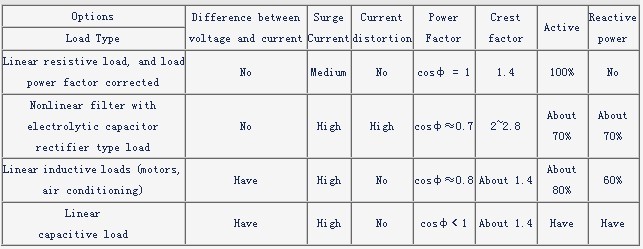·UPS Options
Not all of the electrical equipment will need to use UPS, and equally UPS is not applicable to all electrical equipment. When selecting the UPS, users mainly consider the load size, load device characteristics, the importance of the load device and the adverse impact of power on the load.
Load Device Characteristics
1. AC load power supply is generally divided into two kinds of single-phase and three phase. The low-power load with power from a few hundred VA to 10KVA generally uses the single-phase power supply and UPS of single-phase output; and high-power load with power from tens of KVA to 1000KVA generally uses multi-use three-phase power supply, and therefore required to use three-phase output UPS.
2. Load types are generally divided into resistive, inductive and capacitive linear loads and nonlinear load of rectifying circuit (also known as rectifier load). Computer and related equipment mostly adopt non-linear load. UPS is apply to the negative rectifier and capacitive rectifier loads.
All the non-linear loads cause impulse current in starting period. The peak of rectifier load like computers in normal operation is 2-3, i.e. the peak of current is 2-3 times of its RMS. Therefore, this feature should be taken into account in the selection of UPS to leave some margin to the UPS. For some low power factor inductive load such as air conditioners, etc., because of their large starting current which can up to 5-7 times of its rating, and frequent starting, most small and medium UPS does not apply unless there is adequate margin. Comparison of the load is in the table below:
UPS Load Characteristics
1. the type of the load characteristics

2.the main characteristics of different loads

3. banned UPS load
■ Air conditioner: general prohibition of the use of UPS power supply, since it belongs to inductive load owing to a great starting-impact;
■ Laser printer: selection of UPS power supply with large margin, since impulse current is often produced in the working process;
■ copiers, high-speed line print: same as above
■ Fluorescent: UPS power supply with large margin should be selected, since starting current is higher with higher resistive component
■ heating wire (resistance load): UPS power supply with large margin should be selected, since it belongs to resistive load
■ motor (inductive load): UPS power supply with large margin should be selected, since it belongs to inductive load with high start-impacting.
4. power factor matching and the selection of UPS
Vast majority of computers, communications equipment, control systems and other sophisticated equipment use switching power as the main power, hence based on the above discussion of the nature of the load, most of the computer equipment input power factor is 0.7. The UPS load mainly targets at these sophisticated equipment, and therefore all UPS designs adopt the parameters with output power factor of 0.7 to 0.8, thus maximizing the UPS's load capacity. In the case of matching with the power factor, i.e. the input power factor of the computer loads is 0.7, while the UPS output power factor calibration is also 0.7, the ratio of the load of the VA number and the number of UPS's VA is 1:1, i.e. 1VA UPS capacity without considering the impact of impulse and margin, can carry load of 1VA. If the power factor is not matching, such as resistive load, 1VA capacity can only carry 0.7VA UPS load resistance, or else UPS will be overloaded (even if the VA of UPS load is greater than the number of VA at this moment).
It should be noted that the promotion of some UPS manufacturers that the UPS output power factor is 0 to 1 is actually one-sided, such as interactive UPS and online compensation function three-port UPS. When electricity supply can directly transform the load through the transformer power supply or through compensation of matched UPS load, it can match the other power factor load. And when the mains power blacking out and UPS losing compensation, then the UPS output power factor can only match one value, and the vast majority of manufacturers set the match about 0.7. If the load carried by the power factor at this time does not match the load capacity beyond the scope of UPS, UPS overload will shut down or there will be more serious trouble. Therefore, matching problem of power factor should be considered in the selection of UPS load. If the load is resistive or inductive, UPS capacity should be increased accordingly.
5. computing of load size and UPS capacity
General Electric load will give its rated power or rated current and power factor and other parameters, but big difference exists in different types of loads not allows simply the sum of total power and should seek their vector sum. Fortunately, under normal circumstances, users are mostly computer equipment load, the input power factor is between 0.65-0.7, so each load can be calculated to cumulative total power rated power, while other types of loads, such as individual printers, etc., can be starting current size multiplied by a factor of its rated power into another computer. The total capacity under load, UPS capacity can generally be selected according to the following formula:
- UPS load ≥capacity of a total capacity of /0.8
- The total capacity of the load for the UPS rated capacity should be 80% or less. Selection of 80% mainly takes into account the impact of the impulse current in the starting period, and future expansion of user’s needs.






 Copyright © 2003 - 2023 . All Rights Reserved
Copyright © 2003 - 2023 . All Rights Reserved